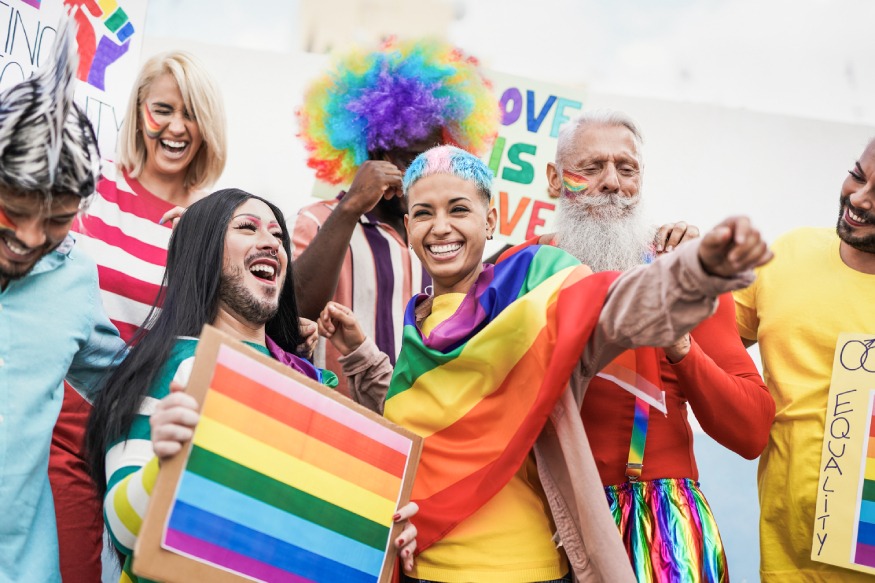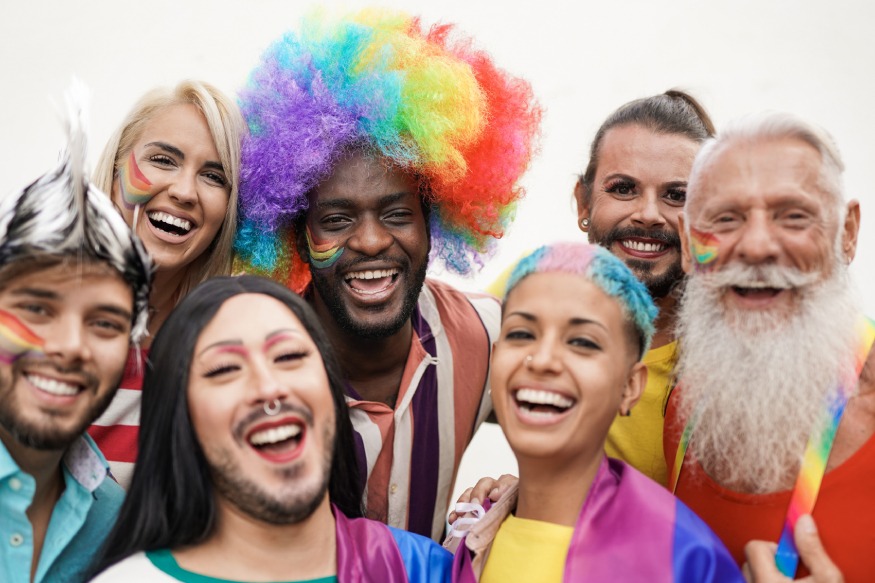
LGBTIQ+: milestones and setbacks

Over the last century, the emancipation of the LGBTIQ+ movement progressed by leaps and bounds. Many milestones have been reached, especially over the last two decades. Laws prohibiting homosexuality have been rolled back, same sex couples can marry and adopt children, and gender-neutral toilets and passports are common in several countries.
Still, it remains a bumpy road, full of setbacks and steps backward. Just look at what’s happening now in Hungary. That’s why it’s important for us to keep paying attention to the struggles and achievements of the generations before us.
Rodney Wilson believed the same: this gay history teacher organised LGBT History Month for the first time in 1994, following the example of Women’s History Month and Black History Month. And rightly so. Because the history of the LGBTIQ movement is also one of protests, barricades, and emancipatory struggles and successes.
Here’s an overview!
From transgender cult to burning at the stake
Believe it or not, in the old days, homosexuality wasn’t really a big issue. In fact, almost all ancient societies have left traces of same sex eroticism. On ceramics, for instance, or in writings. Gender fluidity was also common in most ancient cultures. The “third gender”, which we’d now call non-binary, was often associated with a special spiritual role within the tribe or society.
The first writings about same-sex relationships come from ancient Greece. Adult men engaged in sexual relations with adolescent boys, which the Greeks welcomed for educational reasons. And in both Greece and the Roman Republic, there was a cult in which male followers worshipped the goddess Cybele by castrating themselves, donning women’s clothing and declaring themselves women. We still see these first transgender people as role models today.
Radically reversed
This tolerance was destroyed during the 3rd and 4th centuries. Christianity emerged, and the tolerant and even supportive attitude of the Romans slowly but surely changed into a judgemental one. In 390 AD, Emperor Theodosius I issued a law stating that “men who mate like women” should be burned at the stake.
From the 13th century, homosexual acts became punishable everywhere in Europe. In 1532, the Holy Roman Empire declared the death penalty for homosexuality. The Church pulled out every medieval torture instrument to fight the “corruption of sodomy”. Homosexual men were stoned, castrated, and burned at the stake. Women were also tortured and killed.
The first champions
Thanks to the Enlightenment and the French Revolution, the tide began to turn in the late 18th century. Most Western European countries legalised homosexuality and a relatively quiet period began, with a number of small victories.
New scientific insights emerged, and homosexuality was no longer considered a religious sin but a psychological disorder. From today’s perspective, this hardly seems like progress, but at the time it meant that homosexuals couldn’t do anything about their orientation. And that social condemnation was therefore unjustified.
Concentration camps
However, with the outbreak of National Socialism, a period of persecution began once again. Under the Nazi regime, tens of thousands of gay men were arrested, branded with a pink triangle, and transported to concentration camps. This was a major blow to the emancipation movement, which stagnated for about two decades after the war.
Indeed, despite the ground-breaking research of Alfred Kinsey, who posited in 1948 that human sexual orientation is almost never exclusively homosexual or heterosexual, public opinion remained dismissive. A few years after the development of the Kinsey scale, President Eisenhower even issued an order banning homosexuals from federal jobs. This ban would continue for another 20 years.
Small successes
At the same time, the community also achieved successes. In 1958, the US Supreme Court ruled that the reluctant US Post Office was obliged to deliver the first gay magazine, ONE: The Homosexual Magazine. This was seen as an enormous milestone, just like the fact that Illinois was the first state to abolish “anti-sodomy laws” in 1961, officially making homosexuality no longer a crime.
Still, for ordinary LGBTIQ+ people, the situation wasn’t exactly wonderful. In American suburbs and European neighbourhoods and slums, they were routinely subjected to harassment, abuse, and exclusion. In progressive New York, homosexuals were not even allowed to drink alcohol in bars and had to sit away from other pub-goers.

Pink turning point
The illustrious 1960s turned out to be a pink turning point. An iconic moment? The Stonewall riots in 1969. When the police raided the Stonewall gay bar, the gay movement offered serious resistance for the first time. They threw bottles, fights broke out, and they chanted lines such as “gay power!”. The riots lasted six days and led to the first Gay Pride Parade in 1970. The gay rights movement was now really taking off.
Things began to change in other countries as well. Even before the Stonewall riots, a demonstration was held at the Binnenhof in the Netherlands. Why? Homosexuality was seen as a disorder, something perverse to which young people were being seduced. Because of this homophobic way of thinking, the limit for sexual contact between homosexuals was 21 years, instead of 16 years for heterosexuals. The 100 people present demonstrated for a lowering of the age limit and with success. In 1971, the controversial article of the law was scrapped.
Colourful marches and demonstrations
The genie couldn’t be put back in the bottle. While homosexuals hadn’t dared to come out throughout the 1950s and 1960s, things changed completely in the 1970s. There were marches and demonstrations to abolish anti-gay laws and protect homosexuals from oppression in schools, on the streets, and in their social environments.
Colourfully dressed and openly gay, the demonstrators took to the streets, claiming their right to be who they are. They succeeded, as more and more countries decriminalized homosexuality. In 1973, the authoritative DSM also removed homosexuality from its list of mental disorders.
AIDS and same-sex marriage
Unfortunately, AIDS dealt a bitter blow to the gay community. In the early 1980s, the disease was particularly prevalent among gay men and drug users, fuelling fear, confusion, and hatred. Solidarity within the community grew, but to the outside world, this “gay disease” confirmed all of the subtle prejudices that still existed regarding homosexuality.
However, in the 1990s, public opinion slowly but surely became more positive. Openly gay people conquered the cultural world and the representation of homosexuals in the media became more and more evident. The highlight of this phase? Gay marriage! The Netherlands had the world’s first ceremony in 2001, when Anne-Marie and Hélène became the first gay couple to say “I do”.
Where does the LGBTIQ+ movement stand now?
A lot of progress has been made in recent years. In the European Union, consensus has emerged on the human rights of the LGBTIQ+ community, which has been followed by a range of laws.
Some examples: gay marriage has been legalised, there are equal rights in employment and housing, and protection against homophobia and transphobia is better established. We also enjoy the right to free sexuality, the right to adoption, and the right to gender reassignment. Many companies have “pink tables” and Pride communities, and schools are actively engaged in discussing sexual diversity.
Meaningful?
Still, we haven’t reached our goals yet, says Laurens Buijs, lecturer in gender studies at the University of Amsterdam. He points out that even in a progressive country like the Netherlands, many LGBTIQ+ young people struggle with depression, eating disorders, and addiction. They’re still not completely safe walking down the street. In that light, the assault on 14-year-old Frederique was a painful blow to the Dutch self-image as a tolerant country.
The fact that aggression against LGBTIQ+ people is disturbingly common is also reflected in the statistics. For example, the Dutch COC found that the number of discrimination and violence incidents in 2018 had risen sharply compared to the previous ten years. Some seven in ten LGBTIQ+ people experience physical and verbal violence. In football canteens, talk shows, and cabaret shows, “gay” is still used as a swear word. Our so-called tolerance doesn’t seem that meaningful.
Homophobic countries
At the same time, the Netherlands remains a paradise of broad-mindedness compared to openly homophobic countries like Hungary and Russia. In Russia, for example, a law has been in place since 2013 that bans “propaganda for non-traditional sexual relationships”.
Hungary went a step further earlier this year by banning books, films, and other media with homosexual content, as well as advertising featuring homosexuality or transsexuality. Schools risk a fine of €300 if someone wants to provide information on LGBTIQ+ topics. Despite all the demonstrations and political outrage, the Hungarian LGBTIQ+ community is suffering under laws that set them back several decades.
There’s work to do!
While much has been achieved globally, homosexuality remains a strong taboo in several countries. And LGBTIQ+ people are still too often the victims of discrimination, exclusion, and even persecution.
There’s plenty of work to be done! And all of it starts with knowing and understanding the history. Let’s celebrate LGBT History Month!








Respond or ask a question
0 comments